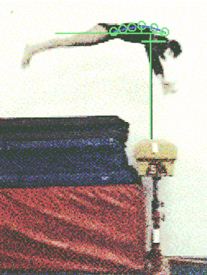JUDGING GYMNASTICS WITH BIOMECHANICS Wm A Sandsa PhD, Jeni R McNeal MS CSCS Department of Exercise & Sport Science, University of Utah, Salt Lake City, Utah 84112. aCorresponding author: wmasands@concentric.net Sportscience 3(1), sportsci.org/jour/9901/was.html, 1999 (865 words) Reviewed by Todd L Allinger, Resource Center for Sport Science, Medicine & Education, The Orthopedic Specialty Hospital, Salt Lake City, Utah 84107
|
|
In sports like gymnastics, judging competitors is notoriouslypolitical and subjective. Modern biomechanics may provide anobjective way to score the movement of athletes in these sports.Recently we undertook a feasibility study of such a scoring systemfor USA Gymnastics. We used video digitizing, infrared timers, and a computeralgorithm to "judge" compulsory vaulting of 25 gymnasts at the 1999American Classic Competition in Pomona, California. The InternationalGymnastics Federation has dropped compulsory routines, but USAGymnastics wants to maintain the educational aspects of compulsoryexercises by designing national compulsories that emphasize crucialaspects of performance. We compiled the score from a custom program for evaluation of therun-up and a commercially available program that permitted handdigitizing of a gymnast's image. A single human judge observed theperformance for form errors and applied a deduction to the scoreprovided by computer analysis. Coaches and officials were very pleased with the outcome of thefirst trial. The time required to perform the measurements wasapproximately 90 seconds per vault, which compares well with the timerequired for human judges to perform the same functions. The coaches,judges, and officials found that the scores conformed well with thescores expected for the individual vault. The second trial of thesystem will occur this July at the US Classic Competition inRochester, New York. TechnicalInformation The timing system (Brower Timing Systems, Draper, Utah) consistedof six infrared sensors on tripods placed in pairs along the vaultrunway. The telemetered timing system was interfaced to a laptopcomputer via custom software to provide millisecond resolution ofrun-up time intervals. The infrared sensors were set at 1.52-meterintervals beginning at 10.7 meters. The six sensor pairs providedfive intervals from which the computer software determined if theathlete maintained acceleration from interval to interval. Pointswere awarded for a continuing acceleration throughout the latter partof the run-up. We assessed the kinematics of the vault with proprietary software(NEAT Systems, Annapolis, Maryland). The software enables recordingand displaying of video sequences. Distances are calibrated prior tosequence analysis. The software also permits the repeateddigitization of a single point with a running displacement and speedvalue displayed for each digitized point. We recorded each athleteís performance with a computer framegrabber and
stored it on the computerís hard disk. We thendisplayed the video sequence
and selected the field showing themoment of departure from the horse. We
recorded the height of the hipjoint, then digitized the hip-joint center
frame-by-frame to depictthe path of the trajectory of the gymnast. We assumed
the hip jointrepresented the gymnast's center of mass. We also recorded the
peakheight of the flight trajectory and the distance of the peak from
thehorse.
Figure 1 shows a gymnast performing a compulsory Yurchenko vault"timer" onto a mat stack. A timer is a gymnastics term for thecrucial or fundamental portion of a gymnastics skill. The nationalcoaching staff determined and prescribed the crucial aspects of eachskill. The timer for the Yurchenko consisted of all parts of thevault except the final somersault and landing. The purpose of thiscompulsory vault was to encourage athletes to perform the earlyphases, from the run up to horse departure, with virtuosity. Figure 1 shows the gymnast in the latter phase of post-flight. Thevertical
line from the horse indicates the height of the gymnast fromhand to hip. The
long horizontal line indicates the height of the hipat horse departure. The
circles show the digitized path of thegymnast's hip in each frame of the
post-flight. The height of thetrajectory is the maximum distance above the
horizontal line at horsedeparture. The line slightly below the digitized
circles shows thedistance of the post-flight. We used the lengths of these
lines tocalculate the gymnastís score. We calculated relativedisplacements by
dividing post-flight height and post-flighthorizontal distance by the height
of the gymnast from hands to hip. Acomputer algorithm then calculated
weighted scores based on theheight and distance of the flight, and whether
the gymnastaccelerated through all parts of the run-up. ©1999 |
